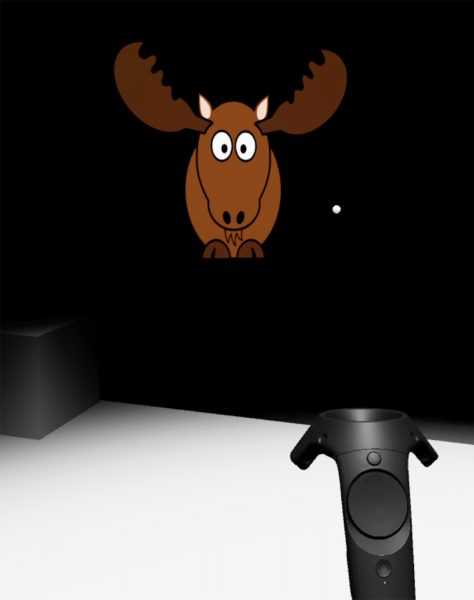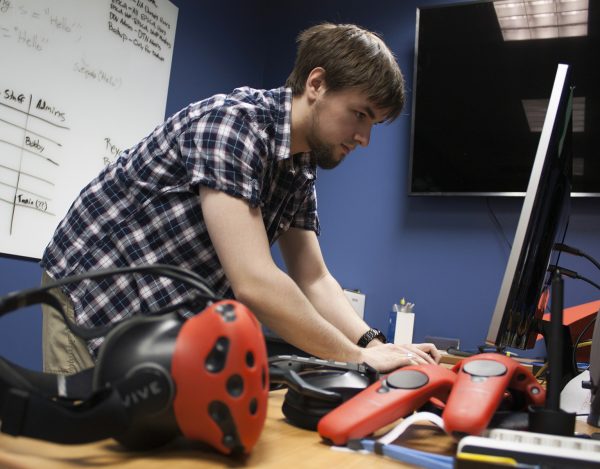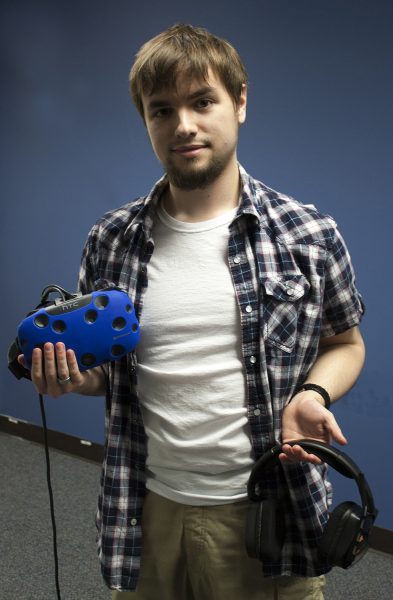Loose moose helps find keys to user-friendly virtual reality
June 8, 2018
Tom Moran
907-474-5581

I’m inside a silent, pitch-black room, being stalked by a relentless cartoon moose.
The ungulate slowly materializes out of the darkness to my left, vanishing as soon as it catches my eye. It reappears behind me, accompanied by the sound of footsteps, then to my right, highlighted by a glow from above. Every time, seconds after I turn to spot him, the moose disappears.
Ten feet away, outside the confines of my virtual reality headset and headphones, recent University of Alaska Fairbanks graduate Tristan Craddick watches patiently. Craddick is demonstrating his senior Honors Program thesis: a clever test to determine the most effective way to direct someone’s gaze in a VR world.
“I wanted to look and see whether, in a virtual reality environment, audio cues or visual cues are more effective at directing a user’s attention,” said Craddick, who was selected as UAF’s 2018 outstanding student in computer science.
“If you were to take traditional film or game design, the director always has control over where the camera is pointing, and that’s where the viewer is looking. In virtual reality, you can’t manipulate the camera … so that poses a challenge of how to direct the user toward a particular element of your scene you want them to see.”
Craddick got the idea for the thesis while working as a student assistant for the National Science Foundation's Established Program to Stimulate Competitive Research. He used EPSCoR’s visualization development space on UAF’s West Ridge, which includes two full VR setups.
Craddick said despite the growing interest in VR technology, he couldn’t locate much existing research regarding ways to make it more user-friendly.

“One of the ideas that kept coming about was how to make the technology be more accessible for people, how to make it more intuitive for people to use,” he said. “One way to do that is through proper software design, but there really isn’t a lot of consensus on the proper techniques.”
So Craddick designed an experiment. He built a virtual room with an object (the moose) that slowly materializes at random out of the participant’s view, either accompanied by a steadily brightening light, the sound of footsteps or no cue at all. As soon as the participant looks at the moose for two seconds, it vanishes and reappears again. The process repeats 30 times, and the person's response times are recorded.
Craddick planned to run the experiment on 100 volunteers, but discovered he didn’t need to. “I had a lot of issues trying to get people to participate, unfortunately,” he said. “I was still far away from the 100 participants I was originally going for, but when I was analyzing my data, I realized I already had enough to come to some conclusive results.”
As it turned out, the audio cues won by a significant margin. On average, participants found the moose in 4.8 seconds when they heard the footsteps, versus about 6.5 seconds for both the light cue and the control group. That’s a 29 percent difference.

Craddick said it would have been possible to improve the performance of the visual cues by making them more obvious — say, a flashing arrow — but that’s not the point.
“With virtual reality, part of the focus of design is immersion — you don’t really want to make them think, oh yeah, I’m wearing a headset, this is all just some type of software,” he noted. “You want to make them think they’re in the scene.”
Craddick turned his findings into a four-page thesis, which he and his advisor, associate professor of computer science Orion Lawlor, hope to have published. He also made a research poster, which he presented to the Honors Program and at the UAF Research and Creative Activity Day.
Meanwhile, Craddick is furthering both his career and his education: he will intern this summer with Coupi, Inc., a Fairbanks firm that makes software to model granular materials for industry simulations. He’ll be back on campus in the fall to begin a master’s degree in computer science, which will continue to focus on computer graphics.


